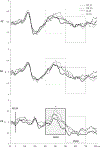Access to verb bias and plausibility information during syntactic processing in adult Spanish-English bilinguals
- PMID: 35757580
- PMCID: PMC9216207
- DOI: 10.1017/s1366728921000924
Access to verb bias and plausibility information during syntactic processing in adult Spanish-English bilinguals
Abstract
In two experiments, we examine how proficient second language speakers integrate verb bias and plausibility information during online sentence comprehension. Spanish-English speakers and native English speakers read sentences in English in which a post-verbal noun phrase (NP) could be interpreted as a direct object or a sentential subject. To examine the role of verb bias, the post-verbal NP was preceded by a verb that is preferentially followed by a direct object (DO-bias verbs) or a sentential complement (SC-bias verbs). To assess the role of plausibility, the semantic fit between the verb and the post-verbal NP was either congruent or incongruent with the direct object interpretation. The results show that both second language speakers and native speakers used verb bias information to assign a grammatical role to the post-verbal ambiguous NP with small differences. Syntactic revision of an initially incorrect DO interpretation was facilitated by the presence of an implausible NP.
Keywords: DO/SC ambiguity; ERPs; Spanish–English bilinguals; ambiguity resolution; event-related potentials; plausibility; second language processing; sentence comprehension; verb bias.
Conflict of interest statement
Competing interest. The authors declare that there is no conflict of interest.
Figures



Similar articles
-
Usage frequencies of complement-taking verbs in Spanish and English: data from Spanish monolinguals and Spanish-English bilinguals.Behav Res Methods. 2010 Nov;42(4):1004-11. doi: 10.3758/BRM.42.4.1004. Behav Res Methods. 2010. PMID: 21139167
-
Plausibility and structural reanalysis in L1 and L2 sentence comprehension.Q J Exp Psychol (Hove). 2023 Feb;76(2):319-337. doi: 10.1177/17470218221092400. Epub 2022 May 13. Q J Exp Psychol (Hove). 2023. PMID: 35319306
-
How Do French-English Bilinguals Pull Verb Particle Constructions Off? Factors Influencing Second Language Processing of Unfamiliar Structures at the Syntax-Semantics Interface.Front Psychol. 2018 Oct 17;9:1885. doi: 10.3389/fpsyg.2018.01885. eCollection 2018. Front Psychol. 2018. PMID: 30405466 Free PMC article.
-
Electrophysiology of prosodic and lexical-semantic processing during sentence comprehension in aphasia.Neuropsychologia. 2017 Dec;107:9-24. doi: 10.1016/j.neuropsychologia.2017.10.023. Epub 2017 Oct 20. Neuropsychologia. 2017. PMID: 29061490 Free PMC article.
-
Mandarin and English Event Cognitive Alignment From Corpus-Based Semantic Fusion Model Perspective.Front Psychol. 2022 May 6;13:872145. doi: 10.3389/fpsyg.2022.872145. eCollection 2022. Front Psychol. 2022. PMID: 35602690 Free PMC article. Review.
Cited by
-
Changes in Native Sentence Processing Related to Bilingualism: A Systematic Review and Meta-Analysis.Front Psychol. 2022 Feb 21;13:757023. doi: 10.3389/fpsyg.2022.757023. eCollection 2022. Front Psychol. 2022. PMID: 35264998 Free PMC article.
References
-
- Berg P and Scherg M (1991) Dipole models of eye movements and blinks. Electroencephalography and Clinical Neurophysiology 79, 36–44. - PubMed
-
- Boland JE (2004) Linking eye movements to sentence comprehension in reading and listening. In Carreiras M & Clifton C Jr. (Eds.). The on-line study of sentence comprehension: Eyetracking, ERP, and beyond Brighton, UK: Psychology Press, pp. 51–76.
-
- Brysbaert M and New B (2009) Moving beyond Kucera and Francis: A critical evaluation of current word frequency norms and the introduction of a new and improved word frequency measure for American English. Behavior Research Methods 41, 977–90. - PubMed
-
- Carreiras M and Clifton C Jr. (2004) On the on-line study of language comprehension. In Carreiras M & Clifton C Jr. (Eds.). The on-line study of sentence comprehension: Eyetracking, ERP, and beyond Brighton, UK: Psychology Press, pp. 1–14.
-
- Chafe W (1988) Punctuation and the prosody of written language. Written Communication 5, 396–426.
Grants and funding
LinkOut - more resources
Full Text Sources
Miscellaneous
